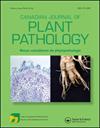小麦条锈病的接种阈值
IF 1.5
4区 农林科学
Q3 PLANT SCIENCES
引用次数: 2
摘要
摘要条锈病(Puccinia striiformis f.sp.tritici(Pst))和白粉菌(Blumeria graminis f.sp.titici(Bgt))是加拿大和世界范围内小麦的重要病害。分子检测方法允许对少数孢子进行孢子检测;因此,需要确定病原体在受控环境和田间引起疾病的初始接种阈值。用不同数量的Pst和Bgt孢子(0、103、104、105、106和107)接种易感小麦品种“Avocet”和“AC Barrie”。评估疾病发生率、严重程度和感染类型。受控环境研究的结果表明,在较高的孢子浓度(105-106个孢子)下,引起显著的Pst发病率和严重程度所需的最小孢子数量。相反,在103–104个孢子中观察到Bgt的发病率和严重程度较低。尽管发生了自然Pst感染,但2016年和2017年在阿尔伯塔省南部的实地研究结果表明,施用1.2×107孢子后,严重程度显著增加。总之,这些结果表明,只有在高孢子水平下,条锈病的严重程度才会随着孢子浓度的增加而增加。相反,Bgt的严重程度随着孢子浓度从103增加到107孢子mL−1。体外和体内孢子发芽试验表明,与较高浓度下的发芽率相比,较低孢子浓度下Pst孢子的发芽率降低。了解疾病发展所需的最小孢子数量将是预测流行病和为未来可持续农业系统制定杀菌剂控制措施的先决条件。本文章由计算机程序翻译,如有差异,请以英文原文为准。
Inoculum threshold for stripe rust infection in wheat
Abstract Stripe rust (Puccinia striiformis f. sp. tritici (Pst)) and powdery mildew (Blumeria graminis f. sp. tritici (Bgt)) are important diseases of wheat in Canada and worldwide. Molecular detection methods permit spore detection of few spores; therefore, there is a need to determine initial inoculum thresholds for pathogens to cause disease under both controlled environments and in the field. Susceptible wheat cultivars ‘Avocet’ and ‘AC Barrie’ were inoculated with different quantities of spores (0, 103, 104, 105, 106, and 107) of Pst and Bgt. Disease incidence, severity and infection type were evaluated. Results of controlled environment studies showed that the minimum number of spores necessary to cause appreciable incidence and severity for Pst was at higher spore concentrations of 105–106 spores. Conversely, low incidence and severity levels were observed at 103–104 spores for Bgt. Despite occurrence of natural Pst infection, results of field studies in 2016 and 2017 in Southern Alberta demonstrated that significant increases in severity levels were observed following application of 1.2 × 107 spores. Collectively, these results demonstrated that stripe rust severities increased with increasing spore concentration only at high spore levels. In contrast, Bgt severity increased with spore concentration from 103 to 107 spores mL−1. In vitro and in vivo spore germination tests demonstrated germination rates of Pst spores were reduced at lower spore concentrations compared to germination rates at the higher concentrations. Understanding of minimum spore numbers required for disease development will be a prerequisite for predicting epidemics and devising fungicide control measures for future sustainable agricultural systems.
求助全文
通过发布文献求助,成功后即可免费获取论文全文。
去求助
来源期刊
CiteScore
4.50
自引率
5.00%
发文量
56
审稿时长
6-12 weeks
期刊介绍:
Canadian Journal of Plant Pathology is an international journal which publishes the results of scientific research and other information relevant to the discipline of plant pathology as review papers, research articles, notes and disease reports. Papers may be submitted in English or French and are subject to peer review. Research articles and notes include original research that contributes to the science of plant pathology or to the practice of plant pathology, including the diagnosis, estimation, prevention, and control of plant diseases. Notes are generally shorter in length and include more concise research results. Disease reports are brief, previously unpublished accounts of diseases occurring on a new host or geographic region. Review papers include mini-reviews, descriptions of emerging technologies, and full reviews on a topic of interest to readers, including symposium papers. These papers will be highlighted in each issue of the journal and require prior discussion with the Editor-in-Chief prior to submission.

 求助内容:
求助内容: 应助结果提醒方式:
应助结果提醒方式:


